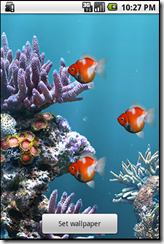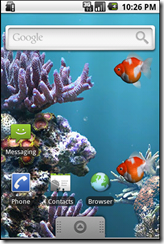Few weeks ago I started learning Android programming, so this article is an outcome of that out-side office study :). Here I will be explaining – how to create a live wallpaper which looks like an aquarium with fishes swimming across the screen. The fish animation is done using sprite technique.
Fish sprite used here is from a code project article
Lets get started…
Creating a new Android project in eclipse (I am not familiar with any other IDEs for Android development :) ). Now create a class for your live wallpaper service, I called it as AquariumWallpaperService, then instantiate the AquariumWallpaperEngine which is responsible for creating the actual Aquarium class which does all the rendering logic. It also controls the flow of Aquarium based Surface callbacks Below is the code for AquariumWallpaperService
1 2 3 4 5 6 7 8 9 10 11 12 13 14 15 16 17 18 19 20 21 22 23 24 25 26 27 28 29 30 31 32 33 34 35 36 37 38 39 40 41 public class AquariumWallpaperService extends WallpaperService @Override public Engine onCreateEngine () return new AquariumWallpaperEngine(); } class AquariumWallpaperEngine extends Engine private Aquarium _aquarium; public AquariumWallpaperEngine () this ._aquarium = new Aquarium(); this ._aquarium.initialize(getBaseContext(), getSurfaceHolder()); } @Override public void onVisibilityChanged (boolean visible) if (visible){ this ._aquarium.render(); } } @Override public void onSurfaceChanged (SurfaceHolder holder, int format, int width, int height) super .onSurfaceChanged(holder, format, width, height); } @Override public void onSurfaceCreated (SurfaceHolder holder) super .onSurfaceCreated(holder); this ._aquarium.start(); } @Override public void onSurfaceDestroyed (SurfaceHolder holder) super .onSurfaceDestroyed(holder); this ._aquarium.stop(); } } }
Aquarium class wraps all the rendering logic, as well as creating the fishes. This also starts a thread which is responsible for updating the view.
1 2 3 4 5 6 7 8 9 10 11 12 13 14 15 16 17 18 19 20 21 22 23 24 25 26 27 28 29 30 31 32 33 34 35 36 37 38 39 40 41 42 43 44 45 46 47 48 49 50 51 52 53 54 55 56 57 58 59 60 61 62 63 64 65 66 67 68 69 70 71 72 73 74 75 76 77 78 79 80 81 82 public class Aquarium private AquariumThread _aquariumThread; private SurfaceHolder _surfaceHolder; private ArrayList<Renderable> _fishes; private Bitmap _backgroundImage; private Context _context; public void render () Canvas canvas = null ; try { canvas = this ._surfaceHolder.lockCanvas(null ); synchronized (this ._surfaceHolder) { this .onDraw(canvas); } }finally { if (canvas != null ){ this ._surfaceHolder.unlockCanvasAndPost(canvas); } } } protected void onDraw (Canvas canvas) this .renderBackGround(canvas); for (Renderable renderable : this ._fishes) { renderable.render(canvas); } }; public void start () this ._aquariumThread.switchOn(); } public void stop () boolean retry = true ; this ._aquariumThread.switchOff(); while (retry) { try { this ._aquariumThread.join(); retry = false ; } catch (InterruptedException e) { } } } public int getLeft () return 0 ; } public int getRight () return this ._backgroundImage.getWidth(); } public void initialize (Context context, SurfaceHolder surfaceHolder) this ._aquariumThread = new AquariumThread(this ); this ._surfaceHolder = surfaceHolder; this ._fishes = new ArrayList<Renderable>(); this ._context = context; BitmapFactory.Options options = new BitmapFactory.Options(); options.inPurgeable = true ; this ._backgroundImage = BitmapFactory.decodeResource(context.getResources(), com.plugai.android.livewallpapers.R.drawable.aquarium, options); this .addFishes(); } private void addFishes () Point startPoint = new Point(100 , 100 ); this ._fishes.add(new ClownFish(this ._context, this , startPoint, 90 )); Point startPoint1 = new Point(100 , 300 ); this ._fishes.add(new ClownFish(this ._context, this , startPoint1, 50 )); Point startPoint2 = new Point(200 , 200 ); this ._fishes.add(new ClownFish(this ._context, this , startPoint2, 15 )); } private void renderBackGround (Canvas canvas) { canvas.drawBitmap(this ._backgroundImage, 0 , 0 , null ); } }
Here is the code for AquariumThread class
1 2 3 4 5 6 7 8 9 10 11 12 13 14 15 16 17 18 19 20 21 22 23 24 25 26 27 28 29 30 31 32 33 34 35 public class AquariumThread extends Thread private Aquarium _aquarium; private boolean _running; public AquariumThread (Aquarium aquarium) this ._aquarium = aquarium; } public void switchOn () this ._running = true ; this .start(); } public void pause () this ._running = false ; synchronized (this ){ this .notify(); } } public void switchOff () this ._running = false ; synchronized (this ){ this .notify(); } } @Override public void run () while (this ._running){ this ._aquarium.render(); } } }
All the renderable object in the aquarium must implement an interface Renderable, which has got one single method called render(…)
1 2 3 4 5 6 7 package com.plugai.android.livewallpapers;import android.graphics.Canvas;public interface Renderable void render (Canvas canvas) }
This interface helps to render an object other than a fish, like plants etc… in future. I have created another abstract class which has common functionalities like changing the position and direction of a fish after a particular interval and called it as AquaticAnimal, this is because I could create specific fishes which just differ by it’s look by extending from this class.
1 2 3 4 5 6 7 8 9 10 11 12 13 14 15 16 17 18 19 20 21 22 23 24 25 26 27 28 29 30 31 32 33 34 35 36 37 38 39 40 41 42 43 44 45 46 47 48 49 50 51 52 53 54 55 56 57 58 59 60 61 62 63 64 65 66 67 68 69 70 71 72 public abstract class AquaticAnimal implements Renderable private static int MAX_SPEED = 100 ; private Context _context; private Aquarium _aquarium; private FishSprite _leftSprite; private FishSprite _rightSprite; private int _direction = -1 ; private int _speedFraction; private long _previousTime; public AquaticAnimal (Context context, Aquarium aquarium) this ._context = context; this ._aquarium = aquarium; } protected void initialize (Bitmap leftBitmap, Bitmap rightBitmap, int fps, int totalFrames, Point startPoint, int speed) this ._leftSprite = new FishSprite(leftBitmap, fps, totalFrames, startPoint); this ._rightSprite = new FishSprite(rightBitmap, fps, totalFrames, startPoint); this ._speedFraction = (MAX_SPEED / speed) * 10 ; } private FishSprite getSprite () if (this ._direction < 0 ){ return this ._leftSprite; } return this ._rightSprite; } public int getDirection () FishSprite sprite = this .getSprite(); int xPos = sprite.getXPos(); if (this ._direction < 0 ){ xPos += sprite.getWidth(); } if (xPos < this ._aquarium.getLeft()){ this ._direction = 1 ; }else if (xPos > this ._aquarium.getRight()){ this ._direction = -1 ; }else { } return this ._direction; } public Context getContext () return this ._context; } public Aquarium getAquarium () return this ._aquarium; } @Override public void render (Canvas canvas) long currentTime = System.currentTimeMillis(); this .getSprite().render(canvas, currentTime); this .swim(currentTime); } public void swim (long currentTime) long diff = currentTime - this ._previousTime; if (diff > this ._speedFraction){ int currentX = this .getSprite().getXPos(); this .getSprite().setXPos(currentX + this .getDirection()); this ._previousTime = currentTime; } } }
The sprite animation is moved into a specific class FishSprite
1 2 3 4 5 6 7 8 9 10 11 12 13 14 15 16 17 18 19 20 21 22 23 24 25 26 27 28 29 30 31 32 33 34 35 36 37 38 39 40 41 42 43 44 45 46 47 48 49 50 51 52 53 54 55 56 57 58 59 60 61 62 63 64 65 66 67 68 69 70 71 72 73 74 75 76 77 78 79 80 81 82 83 84 85 86 87 88 89 90 91 public class FishSprite private Bitmap _currentSpriteBitmap; private Rect _drawRect; private int _fps; private int _noOfFrames; private int _currentFrame; private long _timer; private int _spriteWidth; private int _spriteHeight; private Point _position; public FishSprite (Bitmap spriteBitmap, int fps, int frameCount, Point startPoint) this .initialize(); this ._position = startPoint; this ._currentSpriteBitmap = spriteBitmap; this ._spriteHeight = spriteBitmap.getHeight(); this ._spriteWidth = spriteBitmap.getWidth() / frameCount; this ._drawRect = new Rect(0 ,0 , this ._spriteWidth, this ._spriteHeight); this ._fps = 1000 / fps; this ._noOfFrames = frameCount; } private void initialize () this ._drawRect = new Rect(0 ,0 ,0 ,0 ); this ._timer = 0 ; this ._currentFrame = 0 ; } private void Update (long currentTime) if (currentTime > this ._timer + this ._fps ) { this ._timer = currentTime; this ._currentFrame +=1 ; if (this ._currentFrame >= this ._noOfFrames) { this ._currentFrame = 0 ; } } this ._drawRect.left = this ._currentFrame * this ._spriteWidth; this ._drawRect.right = this ._drawRect.left + this ._spriteWidth; } public void render (Canvas canvas, long currentTime) this .Update(currentTime); Rect dest = new Rect(getXPos(), getYPos(), getXPos() + this ._spriteWidth, getYPos() + this ._spriteHeight); canvas.drawBitmap(this ._currentSpriteBitmap, this ._drawRect, dest, null ); } public Point getPosition () return _position; } public void setPosition (Point position) this ._position = position; } public int getYPos () return this ._position.y; } public int getXPos () return this ._position.x; } public void setYPos (int y) this ._position.y = y; } public void setXPos (int x) this ._position.x = x; } public int getWidth () return this ._spriteWidth; } public int getHeight () return this ._spriteHeight; } }
Now to the final bit, that is creating a fish. you might have noticed that I have created an object of ClownFishin the Aquarium class. ClownFish is just a derived class from AquaticAnimal, with a specific sprite image. So if you have sprite images for a shark, you could simple extend a new class for a shark with that image.
1 2 3 4 5 6 7 8 9 10 11 12 13 14 15 16 17 18 19 public class ClownFish extends AquaticAnimal private static final int TOTAL_FRAMES_IN_SPRITE = 20 ; private static final int CLOWN_FISH_FPS = 20 ; public ClownFish (Context context, Aquarium aquarium, Point startPoint, int speed) super (context, aquarium); BitmapFactory.Options options = new BitmapFactory.Options(); options.inPurgeable = true ; Bitmap leftBitmap = BitmapFactory.decodeResource(getContext().getResources(), com.plugai.android.livewallpapers.R.drawable.left, options); BitmapFactory.Options options1 = new BitmapFactory.Options(); options1.inPurgeable = true ; Bitmap rightBitmap = BitmapFactory.decodeResource(getContext().getResources(), com.plugai.android.livewallpapers.R.drawable.right, options1); this .initialize(leftBitmap, rightBitmap, CLOWN_FISH_FPS, TOTAL_FRAMES_IN_SPRITE, startPoint, speed); } public void render (Canvas canvas) super .render(canvas); } }
Please feel free to go through the code, If I haven’t explained clearly. Hope this article helped some way or other.
Happy new year!!!
Full source code is available here

